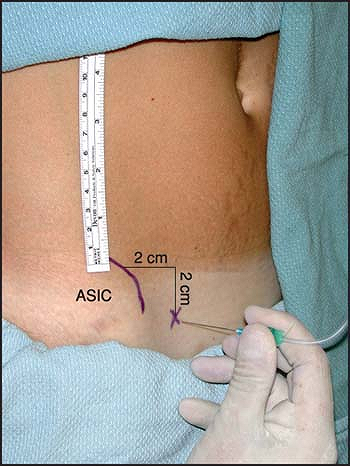Lateral Femoral Cutaneous Nerve Block
Editors: Chelly, Jacques E.
Title: Peripheral Nerve Blocks: A Color Atlas, 3rd Edition
Copyright ©2009 Lippincott Williams & Wilkins
> Table of Contents > Section VII – Pain Blocks > 71 – Lateral Femoral Cutaneous Nerve Block
71
Lateral Femoral Cutaneous Nerve Block
Nashaat N. Rizk
Harinarayan Balasubramanian
In the diagnosis and treatment of meralgia paresthetica, a neuritic
type of pain in the lateral aspect of the thigh. Also can be used for
surgical anesthesia for tourniquet pain in lower limb surgery and for
skin graft harvest.
After sterile preparation of the region, the most medial part of the
anterior superior iliac spine is palpated, and a point 1 cm medial to
it is marked. Next, a vertical line is extended caudally just below the
inguinal ligament to determine the site of introduction of the needle (Fig. 71-1).
The site is prepared with Betadine (Purdue Pharma L.P., Stamford, CT).
Next, a 50-mm insulated needle connected to a nerve stimulator (1.5 mA,
2 Hz, 0.3 ms) is introduced perpendicular to the skin until paresthesia
on the lateral border of the thigh is elicited. The needle position is
adjusted to maintain the paresthesia with a current of 0.6 mA. After
negative blood aspiration, the local anesthetic mixture is slowly
injected. The needle is removed, and a Band-Aid (Johnson & Johnson,
Somerville, NJ) is applied.
-
This block can be performed without the use of a nerve stimulator, but the nerve stimulator increases the success rate.
P.453
 |
|
Figure 71-1. Introduction of the needle.
|
Suggested Readings
Bridenbaugh PO, Wedel DJ. The lower extremity: somatic blockade. In: Cousins MJ, Bridenbaugh PO. Neural blockade in clinical anesthesia and management of pain, 3rd ed. Philadelphia: Lippincott-Raven, 1998.
Waldman SD. Lateral femoral cutaneous nerve block. Atlas of interventional pain management. Philadelphia: WB Saunders, 1998.
